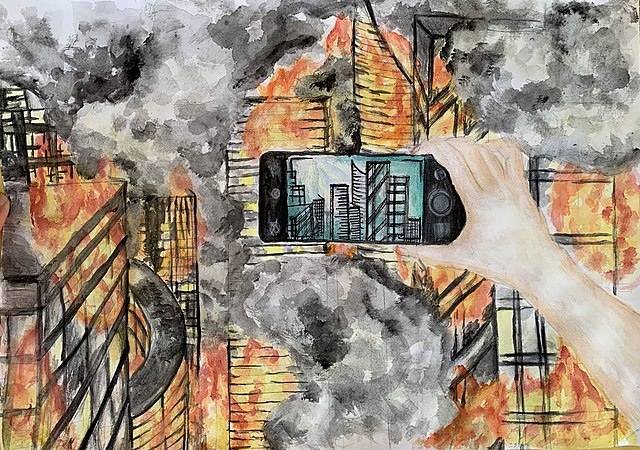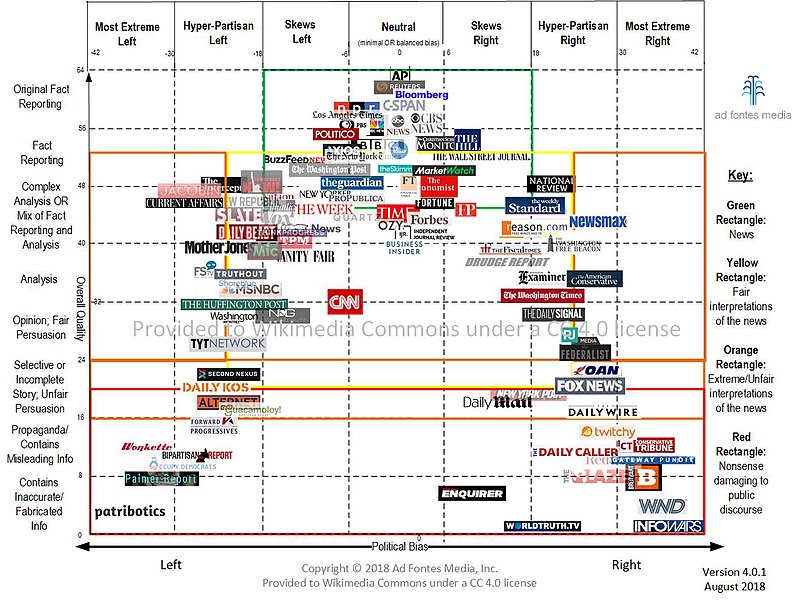The Portrayal of Arabs in the Media

Media Perception. Photo: Wikimedia
By: Joud Sleilaty / Arab America Contributing Writer
Introduction
Media bias is a subject that has garnered widespread attention in public discussions for quite some time. It’s widely acknowledged that even the most trusted and supposedly unbiased news sources often exhibit some degree of bias. But there’s a bigger problem at play, especially when it comes to how the media portrays Arabs and the Middle East. This portrayal has not only been biased but has also led to discrimination and unjust stereotypes against Arabs, which were further intensified in the aftermath of the 9/11 attacks. In this article, we will explore the media’s role in shaping public perceptions in relation to the Middle East, revealing the underlying human bias, country propaganda, and global perspectives.

Media Bias Chart. Photo: Wikimedia
The Middle East : A Dangerous Place?
The Middle East is often labeled as a risky place, primarily due to the numerous conflicts that have occurred there over the years. However, it’s crucial to realize that the Middle East isn’t the only region in the world facing challenges. While it undeniably has its fair share of tensions, other parts of the world, ranging from the Global South to the Global North, also deal with their own significant conflicts. It’s therefore unjust that the Middle East ended up being the region associated with the “unsafe” label.
The notion that the Middle East is not a safe place also deserves closer examination. While some areas within the region experience unrest, the Middle East is not solely defined by conflict and danger; on the contrary, some Middle Eastern countries are even considered to be some of the safest in the world like Qatar, the UAE, Oman, Saudi Arabia, and Bahrain.
Middle East and Human Rights
Another long standing issue brought up by the media is the lack of gender and human rights in certain Middle Eastern countries. Although progress has been made in recent years, it’s crucial to acknowledge that no region, including the United States, has achieved perfection in these areas. The gender pay gap in the U.S., where women earn 82 cents on the dollar compared to men, is an example of an ongoing issue within many others. Thus, while challenges exist in the Middle East, it is not alone in dealing with these complex societal problems.
Arabs and Terrorism
Moreover, one concerning bias in media representation is associating terrorism with Arabs. The definitions of terrorism according to the Federal Bureau of Investigation are categorized into two parts: International and domestic terrorism
- International Terrorism: Violent, criminal acts committed by individuals and/or groups who are inspired by, or associated with, designated foreign terrorist organizations or nations (state-sponsored).
- Domestic Terrorism: Violent, criminal acts committed by individuals and/or groups to further ideological goals stemming from domestic influences, such as those of a political, religious, social, racial, or environmental nature.
Not all acts of violence described as terrorism in the media are consistent. Acts that would be characterized as terrorism but are committed by non-Arabs or non-Muslims are often not referred to as such by the media, revealing a significant bias in the way terrorism is framed and reported.
The Role of Human Biases
The media is, ultimately, a human endeavor. Reporters, writers, and presenters all play a crucial role in shaping news narratives. Their individual perspectives, values, and biases can influence the way a story is framed, which in turn shapes public perception.
For example, the choice of language and sentence structure used in news articles can influence how a story is received. An illustration of this can be found in the reporting of a recent incident involving the death of a Reuters journalist in Lebanon. CNN’s Instagram post, with the sentence, “Journalists hit as Israel fired at Lebanon were clearly marked as press,” seemed oddly phrased, seemingly making an unusual effort to shift responsibility.
Additionally, the facial expressions and tone of presenters can influence viewers’ perceptions. The way a sentence is read, the choice of adjectives used, and the visual cues given during a broadcast all contribute to the shaping of public opinion. These details can either reinforce or challenge existing biases.
Country Propaganda
The issue of discrimination and bias in media portrayal extends beyond the work of journalists and news organizations. It is also influenced by the policies and propaganda of certain countries. For instance, the ban on Muslim immigration implemented during the Trump administration and the French ban on the hijab reflect a broader trend of anti-Muslim propaganda. Such policies not only perpetuate stereotypes but also have real-world consequences, creating discrimination and division.
The War in Gaza and the Media
In recent events in Gaza, media bias has played a significant role in shaping perceptions. The differing portrayals of Israel and Palestine, along with shadow bans on social media discussions about Palestine, have raised concerns about unfair media representation. Moreover, TV news channels have predominantly favored Israel’s perspective, amplifying the sense of imbalance in the coverage. When Gaza strikes, it is frequently portrayed as a terrorist attack, with little room for nuance. However, when Israel is involved, media outlets present justifications that sometimes don’t even align with the reasons shared by other channels. These issues underscore the need for more equitable and unbiased media reporting.
Conclusion
In conclusion, addressing media bias requires recognition of complex societal and geopolitical influences. It’s essential to understand that the Middle East is not the sole region facing conflicts, and human bias among reporters and presenters contributes to skewed portrayals. Additionally, the influence of country propaganda should be considered as part of the issue. Acknowledging these factors is the first step toward achieving more balanced and accurate media coverage.
Check out Arab America’s blog here!








